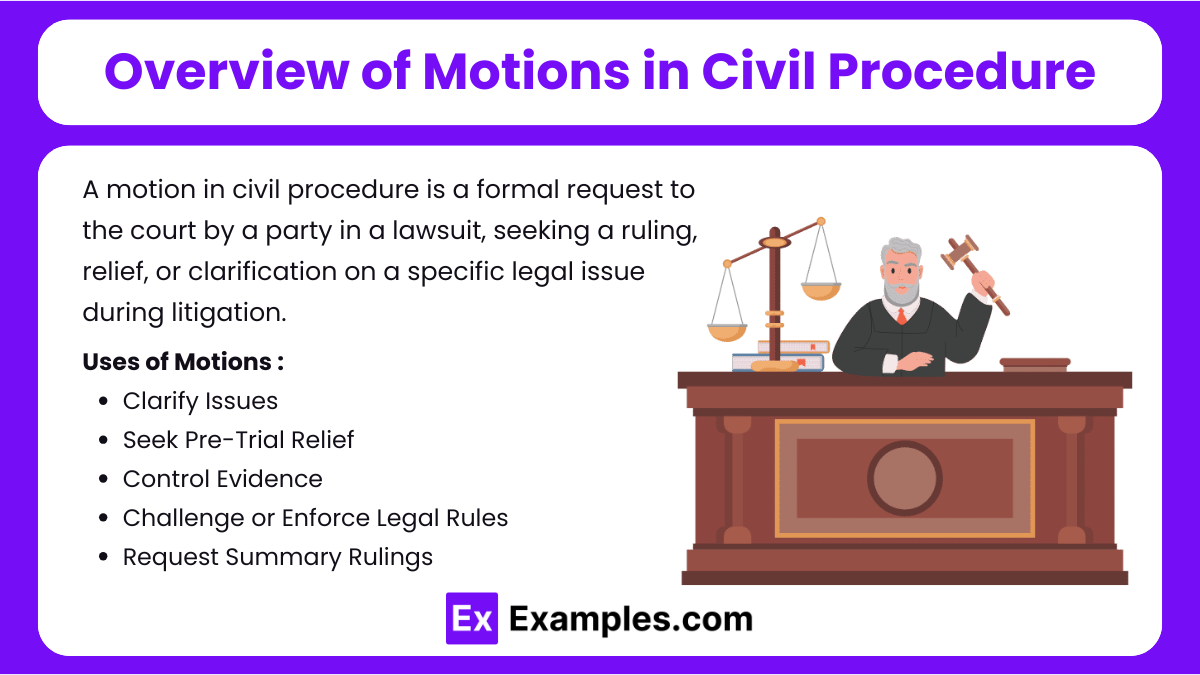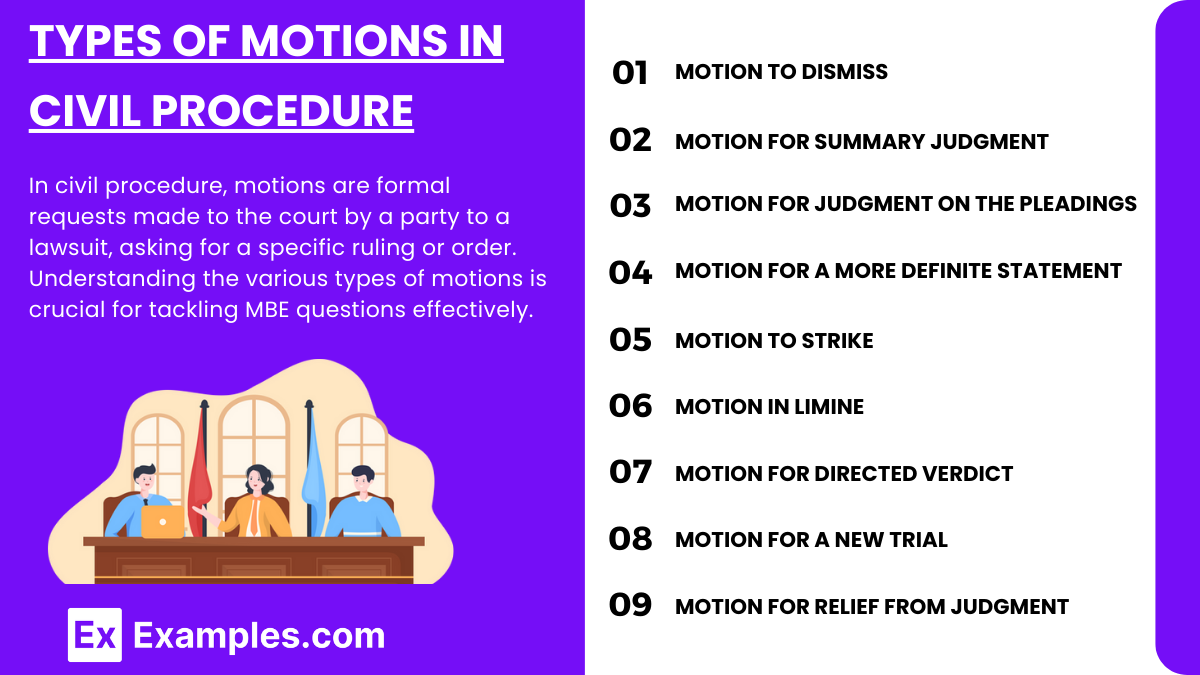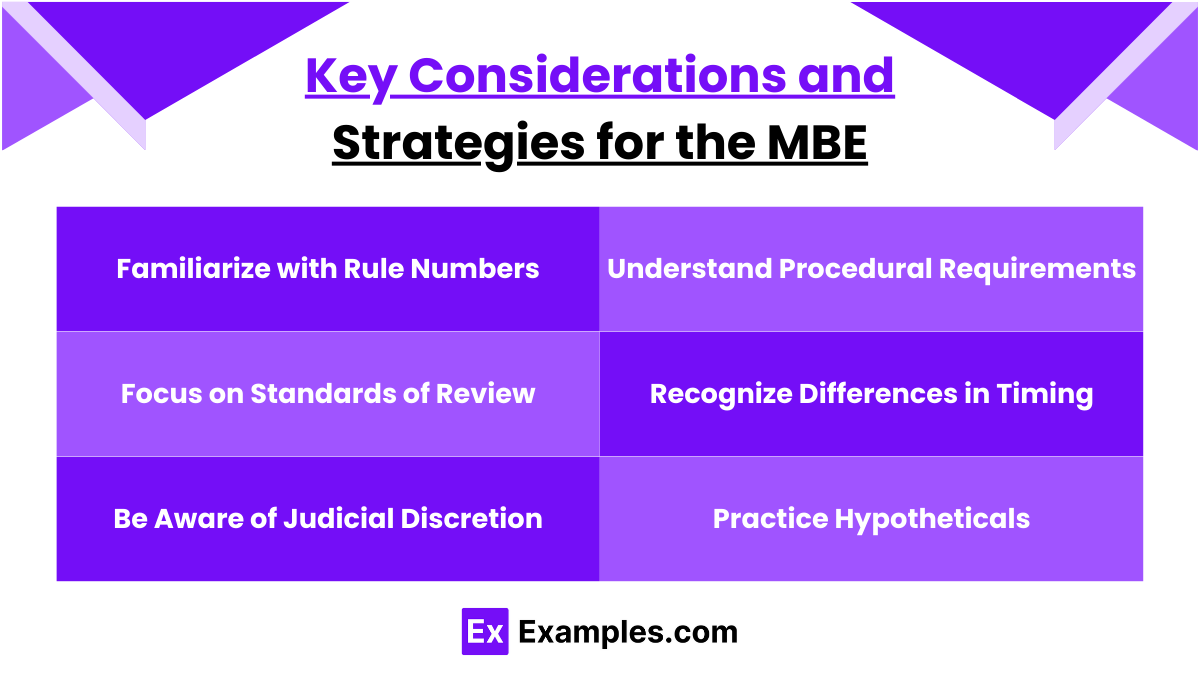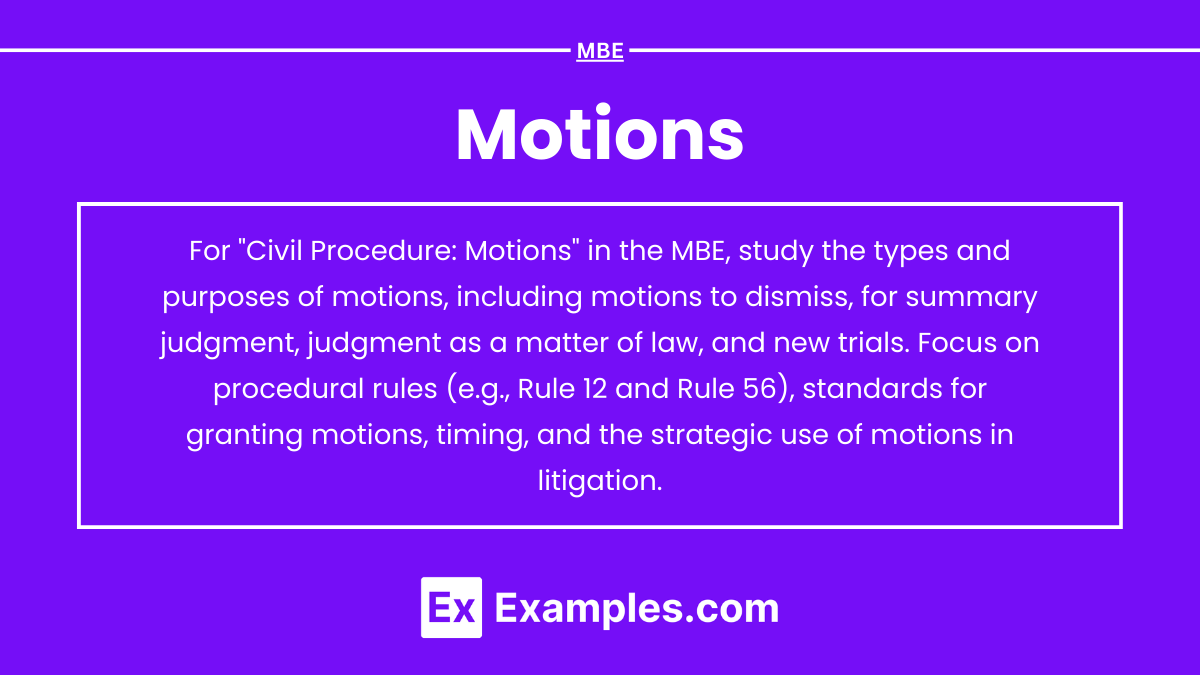In civil litigation, motions are formal requests made to the court by a party seeking a ruling or order on specific procedural or substantive issues. They play a pivotal role in shaping a case's progress by addressing key issues before, during, or after trial. Common motions include motions to dismiss, for summary judgment, or for judgment as a matter of law, each governed by specific procedural rules. Understanding these motions is essential for analyzing case strategy, as they can lead to case dismissal, evidence exclusion, or expedited resolution without a full trial.
Learning Objectives
In studying "Motions" for the MBE Exam, you should learn to understand the variety of motions available within civil litigation, including motions to dismiss, summary judgment, and judgment as a matter of law. Analyze the procedural requirements and strategic considerations behind each motion, focusing on the timing, purpose, and applicable standards for granting relief. Evaluate the legal principles underpinning motions in federal civil procedure, such as Rule 12 and Rule 56. Additionally, explore how these motions shape the course of litigation, influence case outcomes, and assess their application in hypothetical scenarios to enhance your interpretation skills in MBE practice passages.
Overview of Motions in Civil Procedure

In civil procedure, a motion is a formal written or oral request by a party in a lawsuit seeking an order or ruling from the court on a particular issue. Motions serve various purposes, allowing parties to request relief, clarification, or a change in the legal process at different stages of litigation. By filing a motion, a party can request anything from case dismissal, evidentiary rulings, or summary judgment, to enforcing procedural rules.
Motions are powerful tools in litigation strategy, as they can be used to:
Clarify Issues: Motions can define, narrow, or clarify the issues in a case before it goes to trial, such as through motions for a more definite statement or motions to strike.
Seek Pre-Trial Relief: Certain motions, like motions to dismiss, can end litigation early if successful, potentially saving time and resources.
Control Evidence: Motions in limine, for example, help control what evidence can be presented at trial, avoiding prejudicial or irrelevant material.
Challenge or Enforce Legal Rules: Parties can file motions to compel discovery, sanction misconduct, or enforce compliance with procedural rules.
Request Summary Rulings: Motions for summary judgment or judgment on the pleadings allow the court to make a final ruling based on legal arguments without going to a full trial if the facts are undisputed.
Types of Motions in Civil Procedure

Understanding the various types of motions is crucial for tackling MBE questions effectively. Here are the primary types you need to know:
Motion to Dismiss:
Filed early in the litigation, often as a pre-answer motion.
Seeks to dismiss the case due to procedural or substantive deficiencies, such as lack of subject-matter jurisdiction, improper venue, or failure to state a claim.
Governed by Rule 12(b) of the Federal Rules of Civil Procedure (FRCP), with Rule 12(b)(6) being the most common basis (failure to state a claim upon which relief can be granted).
Motion for Summary Judgment:
Filed after the close of discovery, asserting that there are no genuine disputes as to material facts and that the movant is entitled to judgment as a matter of law.
Governed by Rule 56 of the FRCP, summary judgment requires the moving party to show evidence that negates the opponent’s claims or defenses.
It is essential to know that courts view facts in the light most favorable to the non-moving party.
Motion for Judgment on the Pleadings:
Filed after the pleadings are closed but before trial.
Under Rule 12(c) of the FRCP, this motion is based solely on the pleadings, seeking judgment as a matter of law without considering outside evidence.
Motion for a More Definite Statement:
Used when a party believes the opponent’s pleading is too vague to respond to properly.
Governed by Rule 12(e), this motion requests the court to require a more detailed and clear statement of the claim or defense.
Motion to Strike:
Aimed at removing redundant, immaterial, impertinent, or scandalous matter from a pleading.
Governed by Rule 12(f), this motion is commonly used to clean up pleadings and ensure that only relevant facts are presented.
Motion in Limine:
Filed pre-trial to exclude certain evidence from being presented at trial, often because it is prejudicial, irrelevant, or inadmissible under evidentiary rules.
Motions in limine help frame the trial by setting boundaries on the evidence that will be presented to the jury.
Motion for Directed Verdict / Motion for Judgment as a Matter of Law:
Used during a trial when one party believes the opposing party has insufficient evidence to support their case.
In federal court, it’s governed by Rule 50(a), allowing the judge to rule in favor of the moving party if there is no legally sufficient evidentiary basis for a reasonable jury to find in favor of the non-moving party.
Motion for a New Trial:
Filed after a verdict if a party believes there were errors in the trial that affected the outcome, such as improper jury instructions or admission of prejudicial evidence.
Governed by Rule 59, this motion requests a fresh trial to ensure fairness.
Motion for Relief from Judgment:
Filed after a judgment to seek relief from it due to reasons like mistake, inadvertence, newly discovered evidence, fraud, or any other reason that justifies relief.
Governed by Rule 60, it allows parties to address significant issues that may have rendered the original judgment unjust.
Key Considerations and Strategies for the MBE

Familiarize with Rule Numbers: Memorizing rule numbers and their corresponding motions (e.g., Rule 12(b)(6) for failure to state a claim) can save time and aid in recognizing patterns in exam questions.
Understand Procedural Requirements: Many MBE questions focus on the procedural aspects of motions, such as timing, necessary elements, and burden of proof. For instance, knowing that a summary judgment requires showing "no genuine dispute of material fact" is critical.
Focus on Standards of Review: Different motions are assessed using various standards. For example:
Summary judgment is reviewed under a "no genuine dispute of material fact" standard.
Directed verdicts are evaluated based on whether a reasonable jury could find in favor of the non-moving party.
Recognize Differences in Timing: Some motions, such as motions to dismiss, are filed at the beginning of litigation, while others, like motions for a new trial, occur post-judgment.
Be Aware of Judicial Discretion: Judges have considerable discretion in granting or denying many types of motions. For example, a motion in limine is subject to the judge’s determination of relevance and prejudice.
Practice Hypotheticals: MBE questions on motions often involve hypothetical scenarios where you’ll need to identify the correct procedural action based on a set of facts. Practicing these scenarios can improve your ability to quickly spot relevant issues and appropriate motions.
Examples
Example 1: Motion to Dismiss
This motion is typically filed by a defendant early in the case, often before answering the complaint, to challenge the legal sufficiency of the claims. Under Rule 12(b) of the Federal Rules of Civil Procedure, a defendant may argue several grounds for dismissal, such as lack of jurisdiction, improper venue, or failure to state a claim upon which relief can be granted. For example, if a plaintiff files a claim that doesn’t satisfy legal requirements, the defendant might file a Rule 12(b)(6) motion, asking the court to dismiss due to failure to state a valid claim.
Example 2: Motion for Summary Judgment
This motion is used after discovery is complete, often by either party, to argue that there are no genuine disputes of material fact and that the moving party is entitled to judgment as a matter of law. Governed by Rule 56, it requires presenting evidence that negates the opponent’s claim or defense. For instance, if a plaintiff has insufficient evidence of a required element for their case, the defendant may move for summary judgment to avoid trial. The court then assesses if any reasonable fact-finder could find in favor of the non-moving party.
Example 3: Motion for Judgment on the Pleadings
Filed once the pleadings are closed, this motion argues that, based solely on the pleadings, the movant is entitled to judgment as a matter of law. Under Rule 12(c), the court reviews only the initial pleadings, such as the complaint and answer, without considering external evidence. For example, if a defendant admits to all allegations in a complaint but argues that they are insufficient for legal relief, they may seek a judgment on the pleadings.
Example 4: Motion in Limine
This motion is typically filed before trial to exclude specific evidence from being presented. The motion seeks to prevent irrelevant or prejudicial information from reaching the jury, helping control the scope of admissible evidence. For example, if a party wishes to exclude prior criminal history as irrelevant or overly prejudicial, they might file a motion in limine to ensure this information isn’t mentioned at trial. The judge will evaluate if the probative value of the evidence is outweighed by potential prejudice.
Example 5: Motion for a New Trial
Filed by a party after a verdict, this motion argues that substantial errors occurred during the trial, affecting the fairness of the outcome. Under Rule 59, reasons may include procedural errors, incorrect jury instructions, or newly discovered evidence. For example, if a party believes that jury instructions misinterpreted the law, leading to an unfavorable verdict, they may request a new trial on the grounds of judicial error. The court then reviews whether the alleged errors justify retrying the case.
Practice Questions
Question 1
A plaintiff files a lawsuit against a defendant in federal court, claiming breach of contract. The defendant responds by filing a Motion to Dismiss for Failure to State a Claim under Rule 12(b)(6) of the Federal Rules of Civil Procedure. On what basis is the court likely to grant this motion?
A. The complaint lacks specific evidence proving the breach occurred.
B. The complaint fails to provide enough factual allegations to suggest that the breach of contract is plausible.
C. The defendant claims to have evidence disproving the plaintiff’s allegations.
D. The plaintiff did not file any supporting affidavits with the complaint.
Answer: B
Explanation: Under Rule 12(b)(6), a motion to dismiss for failure to state a claim tests the sufficiency of the plaintiff's allegations in the complaint, not the evidence. The standard, derived from cases like Bell Atlantic Corp. v. Twombly and Ashcroft v. Iqbal, requires that the complaint contain enough factual matter, accepted as true, to state a claim that is “plausible on its face.” Answer B is correct because it addresses this standard.
Option A is incorrect because a 12(b)(6) motion does not assess the evidence but only the sufficiency of the allegations.
Option C is incorrect because the defendant’s evidence is not considered at this stage.
Option D is incorrect because affidavits are not required to accompany a complaint; complaints need only contain a plausible set of allegations.
Question 2
During a federal trial, the plaintiff finishes presenting their case-in-chief. The defendant believes the plaintiff has not introduced enough evidence to prove the elements of their claim. The defendant files a Motion for Judgment as a Matter of Law under Rule 50(a). On what basis can the court grant this motion?
A. There is sufficient evidence for the jury to reasonably find for the plaintiff.
B. The defendant has produced evidence that fully contradicts the plaintiff’s case.
C. The plaintiff’s evidence, even if taken as true, would not support a verdict in their favor.
D. The judge believes the jury may have a biased view of the plaintiff’s evidence.
Answer: C
Explanation: A Motion for Judgment as a Matter of Law under Rule 50(a) may be granted if, after considering all evidence in the light most favorable to the non-moving party (here, the plaintiff), there is no legally sufficient evidentiary basis for a reasonable jury to find for that party. Thus, Answer C is correct because it reflects the standard for granting this motion.
Option A is incorrect because if there is sufficient evidence for the jury to find for the plaintiff, the motion should be denied.
Option B is incorrect because the defendant’s contradictory evidence alone is not enough; the motion depends on whether the plaintiff has provided enough evidence to meet their burden.
Option D is incorrect because a judge’s belief about jury bias is not a valid basis for granting this motion.
Question 3
A plaintiff files a federal lawsuit against a defendant for negligence. The defendant believes the lawsuit was filed in the wrong venue and does not respond to the substance of the complaint. What motion should the defendant file to address the issue of improper venue?
A. Motion to Dismiss under Rule 12(b)(3)
B. Motion for Summary Judgment under Rule 56
C. Motion for a More Definite Statement under Rule 12(e)
D. Motion in Limine to exclude evidence of the alleged negligence
Answer: A
Explanation: A Motion to Dismiss under Rule 12(b)(3) is the appropriate motion when challenging improper venue. Venue refers to the appropriate geographic location for a trial, and Rule 12(b)(3) allows the defendant to challenge venue before addressing the merits of the case. Therefore, Answer A is correct.
Option B is incorrect because Motion for Summary Judgment under Rule 56 addresses cases where there is no genuine dispute of material fact, not procedural issues like venue.
Option C is incorrect because Motion for a More Definite Statement is used when a complaint is too vague or ambiguous for a proper response.
Option D is incorrect because a Motion in Limine is used to exclude specific pieces of evidence and is not relevant to venue challenges.


